1936 (approx) Kendrick TWS Tricycle
I like models that ‘buck the trend’ and particularly rare ones such as this Kendrick. Though various early tricycle designs followed the TWS (two-wheeled steering) principle, to my knowledge only Kendrick and Harding continued with this style on adult trikes.
Monarch, also made in Reading, by John Warrick & Co, made a teenage girl’s trike in the 1940s with similar front-steering – CLICK HERE TO SEE IT. I’m sure that the Kendrick would have influenced its design, though the Monarch’s smaller front wheels were closer to the Harding’s style.
(You can view my 1956 Hardings on another page of this website).
The two front wheels and the Ackerman steering takes a bit of getting used to. It’s very different from a conventional adult tricycle with the two wheels behind. The only thing I can compare it to is a Pashley front-carrier box trike, though a box trike has a heavy front end and is a more substantial machine all round, so it feels more stable than an ordinary tricycle.
I’m more used to riding commercial trikes with boxes at the front. There’s more vehicle between rider and any potential obstacle so, by comparison, I feel a bit ‘exposed’ on any adult trike.
But once you’re familiar with it, the Kendrick does feel good to ride. And the two full-size front wheels of the Kendrick provide a luxury ride compared to the small front wheels of the Harding.
***************************************
Considering the interesting design of the Kendrick, I’m surprised that there’s not more information generally available about it.
After a lot of research, I’ve at last completed my Online Museum for John Warrick & Co of Reading – PLEASE CLICK HERE to visit it.
Kendrick was also manufactured in Reading, so I’ll see how much more history I can dig up on Kendrick and add it to this page.
The picture below is from the National Cycle Collection (http://www.cyclemuseum.org.uk/tricycles.htm)
***************************************
The following article is reproduced from the excellent Tricycle Association website (click here to visit it).
ON TWO WHEELS IN FRONT
By Alf Layzell
Printed in the Association Gazette Autumn 1957.
“Since 1867 the tricycle has passed through every conceivable phase of design. By 1866 the three tracked machine with steering wheel in front and driving wheels in rear began to show its superiority over other designs and within eight years this type, known generally as the “Cripper”, became almost universal with regard to wheel arrangement, although there was still a difference in method of drive, some makers using Starley’s balance gear and others the double free-wheel clutch.
The wheel arrangement in common use today results from the survival of the fittest. The first 25 years of tricycling history was a period of strenuous competition between mechanics, engineers and designers, some of whom were men of genius. The battle was won by the “Cripper”. In view of the foregoing it is surprising to the present writer that letters appear in the “T.A. Gazette” from correspondents who seem to think that the tricycle with two wheels to the front never had a fair trial. It did get a fair trial and was beaten. Two machines with two wheels in front were very successful. Both could be easily converted to tandem form. The Olympia tricycle, once the fastest vehicle on the road in its tandem form, was steered by means of the two front wheels controlled on the Ackerman principle. This necessitates the use of a track rod steering arm to give a different degree of obliquity to the wheel when cornering. It was patented by Rudolph Ackerman in 1823 and was first used on steam coaches. Ackerman admitted that the idea had been communicated to him by George Lenchenspurger of Munich. The driving mechanism of the Olympia was the same as that on the Rover Safety bicycle.
The Humber tricycle had the two driving wheels in front. Those were mounted on a balanced geared, or differential, axle. The machine was steered by the back wheel. In its single form the Humber was the favourite among racing men, but it was tricky to ride. The “Cripper” ousted the other types because of it greater stability. On this type of machine the rider has some weight on the steering wheel all the time and is in a position to counteract the changes in camber and sudden reversals of the same by moving his body laterally. This fact enabled makers to fit equal sized wheels. In 1936 Bilbe of Reading built tricycles with same wheel arrangement as the Olympia, and with Ackerman steering.* The late H.W. Bartleet bought one in 1938. I was in India at the time and corresponded with him once a month. Being interested in the machine I asked him what he thought of it. He said that it was awkward to steer at more than 12 miles an hour.”
*NB. This machine was undoubtedly a Kendrick Tricycle, made by The Kendrick Cycle Co. / K.H.Wilkins, Olympia Works, Albert Road, Reading. In 1946 the proprietor was H.S.Bilbe, the inventor of the ‘Endrick’ rim. The tricycle had AcKerman steering, hence ‘Kendrick’.
The ‘Kendrick’ tricycle formerly ridden by the late Tom Norton is in the Cycle Museum at Llandrindod Wells. He rode the tricycle twice a day half a mile to and from his office until about eight months before his death at the age 85 in 1955.
The ‘Kendrick’ tricycle was produced for the Government during the 1939-1945 War as a substitute for an invalid car.
The 1951 Spring “T.A. Gazette” noted that, “H. Bruce Kingsford of Cheltenham, who at 82 still rides his Kendrick tricycle…may well be our oldest active member”. In 1953, in his 85th year, Bruce Kingsford had a ‘K’ type tricycle made for him by T. Higgins and Son Ltd. Details and pictures of this machine can be found on the Higgins page.
(It is interesting to note that Alf Layzell does not mention the post war Harding tricycle with two small wheels to the front and Ackerman steering; or the ‘K’ type tricycle built by Higgins. However, it is thought that there were only three ‘K’ types built.)
Contributed by: Martin Purser, Chris Hewitt, Paul Stevenson and Alf Layzell (reproduce with appreciation)
***************************************
Here’s more about Tom Norton and his Kendrick:
***************************************
The oddity below is a metal and plastic model of a Kendrick, measuring 7cm x 11cm.
***************************************
I subscribe to the ‘Reading Forum,’ where several people have posted details and discussed their motoring memories of the Reading area.
Reading Bicycle manufacturers
Re: Reading Bicycle manufacturers
Pete.
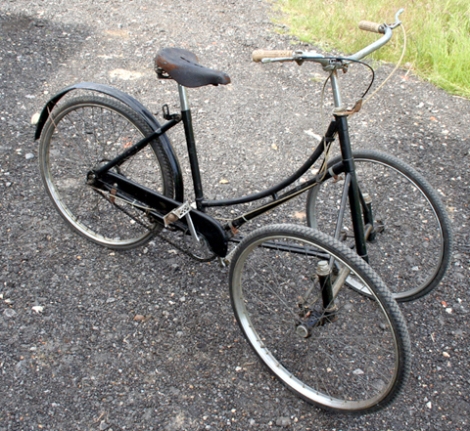
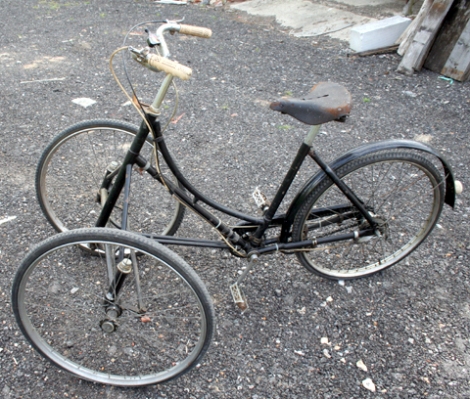
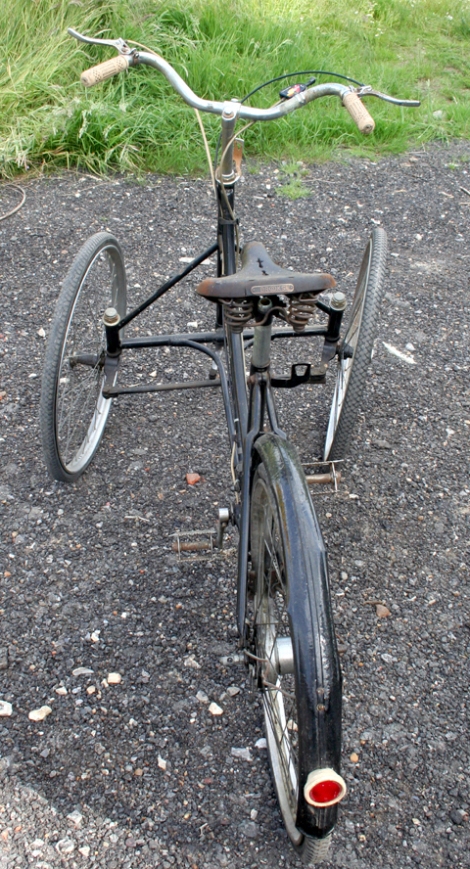
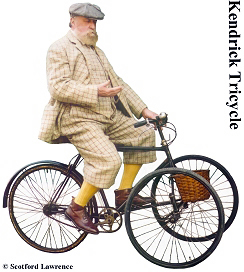
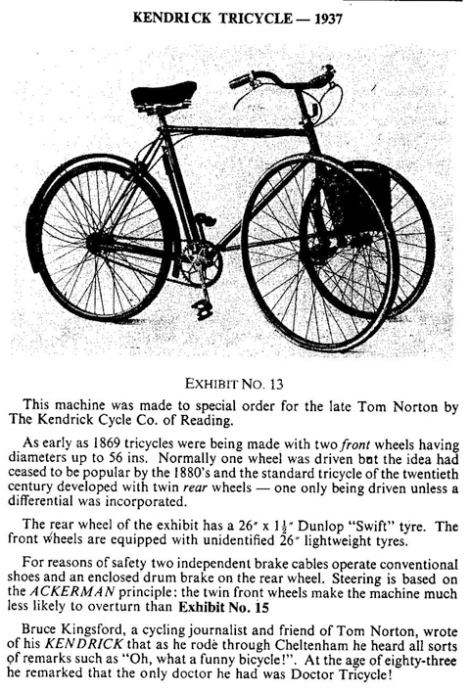
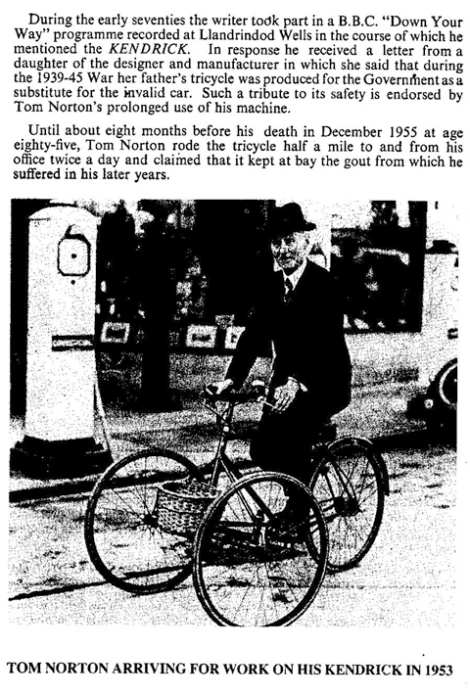

You must be logged in to post a comment.